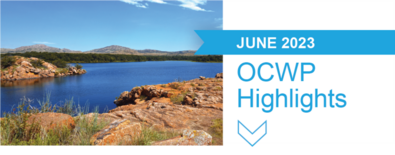 Hope you are enjoying your summer and all the rain we’ve had in the past few weeks! According to the Oklahoma Mesonet, the Panhandle is at 238% of average rainfall over the past month, ranking fourth wettest on record, and we are finally seeing green in several areas!
Have you been celebrating #WorldOceanDay? NOAA reports that the ocean, which covers 70% of Earth’s surface, transports heat from the equator to the poles, regulating our climate and weather patterns. Additionally, the US ocean economy produces around $282 billion in goods and services. Check out EPA’s Oceans and Coast website to learn more about programs that work to protect and restore our nation's waters.
Producers, industry professionals, and academia are engaging in conversations through the Irrigated Agriculture Workgroup to identify local water issues and better understand local root causes. The groups are helping our Team formulate collaborative actions for improving the long-term economic viability of producers, industry, and municipalities in Oklahoma. So far, with help from OSU Extension and other ag-related professionals, two focus groups of producers have met. One in the Panhandle and one in the Southwest. The groups have considered ideas such as expanded soil heath initiatives, cooperatives for local economic development, expanded conservation training and education, to name a few, all with the goal of improving the local trajectory of our irrigation-dependent economy.
The OCWP Team will share what we have learned with a broader audience for feedback and solution-building through a progression of local meetings beginning Fall of 2023 (TBA)
Water solutions that will stand the test of time will be those that plan for the long game, those that bring together multiple local water interests: producers, industry, municipal, and others, and those that acknowledge it best serves local long-term interests when we develop solutions for each of them to succeed.
The Oklahoma Water Resources Center and OSU researchers are studying the use of saline water as an alternative irrigation method to supplement certain crops in extreme drought years. Listen to Dr. Ali Mirchi and Dr. Kevin Wagner talk about alternative supplies here.
The Master Irrigator Program from OSU Extension provides advanced training on irrigation water management, irrigation system and equipment maintenance, energy conservation, water conservation and quality, and the economics of irrigated agriculture. The program includes classroom training, peer-to-peer exchange of information between producers, field demonstrations, and free-of-charge services, such as energy audits, through mobile irrigation laboratories. Instructors include extension specialists, irrigation specialists, and economists from OSU and adjoining states, producers, crop consultants, and NRCS personnel.
The Clean Water State Revolving Fund (CWSRF) 2024 Intended Use Plan Meeting was held Tuesday, June 6. More information is available on the OWRB’s website here.
The US Bureau of Reclamation (USBR) is accepting Letters of Interest (LOI) until June 30 for their Basin Study Program. For more information on a Plan of Study, please see Basin Study Program Requirements. Eligible applicants for Plans of Study and Basin Studies include non-Federal entities such as states, Tribes, irrigation districts, water districts, or any organization located within the 17 Western states with water delivery or management authority. Other types of entities may also be cost-share partners if they partner with an eligible applicant. The Basin Study process will also include opportunities for input from other interested basin stakeholders. The USBR is asking interested non-Federal entities to coordinate with appropriate Reclamation staff in their area on the creation and submittal of a short LOI (not to exceed three pages). The LOI must be submitted to Reclamation’s Missouri Basin and Arkansas-Rio Grande-Texas-Gulf Regions Office by June 20. LOIs may be submitted via email at mlanini@usbr.gov or mail at PO Box 36900 (MB-4600), Billings, MT 59107-6900.
 Be on the lookout for our upcoming meetings across the state! Schedule and locations will be announced soon! *Note: These meetings will function in a series designed to flow in a progression: first learning together about current water projections and foreseen challenges, then broadly discussing strategies to meet those challenges; and ultimately, the meetings could provide interested entities the opportunity to become a work group of their own, to plan together and maybe even build local partnerships across local water sectors to help improve their water future.
I want to welcome our new readers. If you are interested in receiving the OCWP Newsletter directly via email, please subscribe or check out the 2025 Oklahoma Comprehensive Water Plan website.
Best regards to each and every one of you,
Owen Mills | Director of Water Planning | Oklahoma Water Resources Board | 405.530.8904 Office | 405.421.4127 Cell Owen.mills@owrb.ok.gov |